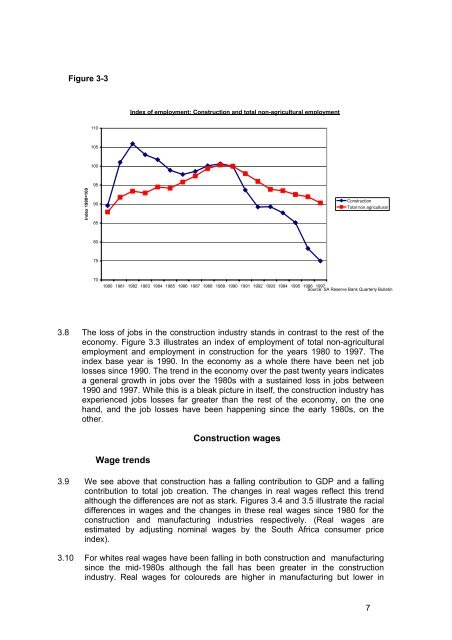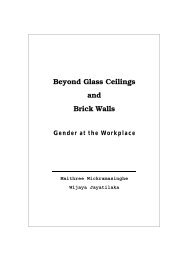SETP No. 14 The Economic Value of Incremental Employment in the ...
SETP No. 14 The Economic Value of Incremental Employment in the ...
SETP No. 14 The Economic Value of Incremental Employment in the ...
You also want an ePaper? Increase the reach of your titles
YUMPU automatically turns print PDFs into web optimized ePapers that Google loves.
Figure 3-3<br />
Index <strong>of</strong> employment: Construction and total non-agricultural employment<br />
110<br />
105<br />
100<br />
Index 1990=100<br />
95<br />
90<br />
85<br />
Construction<br />
Total non agricultural<br />
80<br />
75<br />
70<br />
1980 1981 1982 1983 1984 1985 1986 1987 1988 1989 1990 1991 1992 1993 1994 1995 1996 1997<br />
Source: SA Reserve Bank Quarterly Bullet<strong>in</strong><br />
3.8 <strong>The</strong> loss <strong>of</strong> jobs <strong>in</strong> <strong>the</strong> construction <strong>in</strong>dustry stands <strong>in</strong> contrast to <strong>the</strong> rest <strong>of</strong> <strong>the</strong><br />
economy. Figure 3.3 illustrates an <strong>in</strong>dex <strong>of</strong> employment <strong>of</strong> total non-agricultural<br />
employment and employment <strong>in</strong> construction for <strong>the</strong> years 1980 to 1997. <strong>The</strong><br />
<strong>in</strong>dex base year is 1990. In <strong>the</strong> economy as a whole <strong>the</strong>re have been net job<br />
losses s<strong>in</strong>ce 1990. <strong>The</strong> trend <strong>in</strong> <strong>the</strong> economy over <strong>the</strong> past twenty years <strong>in</strong>dicates<br />
a general growth <strong>in</strong> jobs over <strong>the</strong> 1980s with a susta<strong>in</strong>ed loss <strong>in</strong> jobs between<br />
1990 and 1997. While this is a bleak picture <strong>in</strong> itself, <strong>the</strong> construction <strong>in</strong>dustry has<br />
experienced jobs losses far greater than <strong>the</strong> rest <strong>of</strong> <strong>the</strong> economy, on <strong>the</strong> one<br />
hand, and <strong>the</strong> job losses have been happen<strong>in</strong>g s<strong>in</strong>ce <strong>the</strong> early 1980s, on <strong>the</strong><br />
o<strong>the</strong>r.<br />
Wage trends<br />
Construction wages<br />
3.9 We see above that construction has a fall<strong>in</strong>g contribution to GDP and a fall<strong>in</strong>g<br />
contribution to total job creation. <strong>The</strong> changes <strong>in</strong> real wages reflect this trend<br />
although <strong>the</strong> differences are not as stark. Figures 3.4 and 3.5 illustrate <strong>the</strong> racial<br />
differences <strong>in</strong> wages and <strong>the</strong> changes <strong>in</strong> <strong>the</strong>se real wages s<strong>in</strong>ce 1980 for <strong>the</strong><br />
construction and manufactur<strong>in</strong>g <strong>in</strong>dustries respectively. (Real wages are<br />
estimated by adjust<strong>in</strong>g nom<strong>in</strong>al wages by <strong>the</strong> South Africa consumer price<br />
<strong>in</strong>dex).<br />
3.10 For whites real wages have been fall<strong>in</strong>g <strong>in</strong> both construction and manufactur<strong>in</strong>g<br />
s<strong>in</strong>ce <strong>the</strong> mid-1980s although <strong>the</strong> fall has been greater <strong>in</strong> <strong>the</strong> construction<br />
<strong>in</strong>dustry. Real wages for coloureds are higher <strong>in</strong> manufactur<strong>in</strong>g but lower <strong>in</strong><br />
7
















